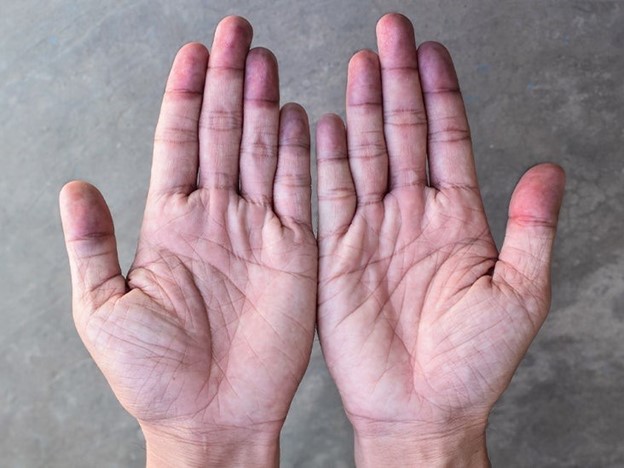A nurse is performing a skin assessment on a client who has dark skin.
Which of the following locations on the client’s body should the nurse observe to assess for cyanosis?
Area of trauma.
Sacrum.
Shoulders.
Palms of the hands.
The Correct Answer is D

Cyanosis is a bluish discoloration of the skin and mucous membranes due to inadequate oxygenation of the blood. It is more difficult to detect in people who have dark skin, so the nurse should look for cyanosis in areas where the skin is thinner and the blood supply is richer, such as the palms of the hands, the lips, the gums, and around the eyes.
These areas are less affected by melanin, the pigment that gives skin its color.
Choice A is wrong because an area of trauma may have bruising or inflammation that can mask cyanosis.
Choice B is wrong because the sacrum is not a good site to assess for cyanosis in any skin tone, as it is prone to pressure ulcers and poor circulation.
Choice C is wrong because the shoulders are not a mucous membrane and may have more melanin than other areas of the body.
Nursing Test Bank
Naxlex Comprehensive Predictor Exams
Related Questions
Correct Answer is A
Explanation
The correct answer is choice A. Instruct the client to avoid coughing during the procedure.
A thoracentesis is a procedure that involves inserting a needle into the pleural space to remove excess fluid or air. Coughing can increase the risk of pneumothorax (collapsed lung) or bleeding during the procedure.
Choice B is wrong because the client does not need to be NPO (nothing by mouth) for 6 hr prior to the procedure. There is no risk of aspiration during a thoracentesis.
Choice C is wrong because the client should be positioned on the unaffected side for 4 hr following the procedure. This allows the affected lung to re-expand and prevents fluid from accumulating in the pleural space again.
Choice D is wrong because the client should not be placed in the prone position during the procedure. The prone position makes it difficult to access the pleural space and can compromise breathing.
Correct Answer is A
Explanation
- Answer and explanation.
The correct answer is choice A. Increased Hct.
Hct stands for hematocrit, which is the percentage of red blood cells (RBCs) in the blood.
A client who received 2 units of packed RBCs should have an increased Hct because they have more RBCs in their blood volume. The normal range for Hct is 38% to 50% for males and 36% to 44% for females.
Choice B is wrong because decreased Hgb means decreased hemoglobin, which is the protein that carries oxygen in the RBCs.
A client who received 2 units of packed RBCs should have an increased Hgb because they have more hemoglobin in their blood. The normal range for Hgb is 13.5 to 17.5 g/dL for males and 12 to 15.5 g/dL for females.
Choice C is wrong because increased platelets means increased thrombocytes, which are the cells that help with blood clotting.
A client who received 2 units of packed RBCs should not have an increased platelet count because they did not receive platelets in the transfusion. The normal range for platelets is 150,000 to 400,000/mm^3.
Choice D is wrong because decreased WBC count means decreased leukocytes, which are the cells that fight infection and inflammation.
A client who received 2 units of packed RBCs should not have a decreased WBC count because they did not receive WBCs in the transfusion. The normal range for WBC count is 4,500 to 11,000/mm^3.
Whether you are a student looking to ace your exams or a practicing nurse seeking to enhance your expertise , our nursing education contents will empower you with the confidence and competence to make a difference in the lives of patients and become a respected leader in the healthcare field.
Visit Naxlex, invest in your future and unlock endless possibilities with our unparalleled nursing education contents today
Report Wrong Answer on the Current Question
Do you disagree with the answer? If yes, what is your expected answer? Explain.
Kindly be descriptive with the issue you are facing.
